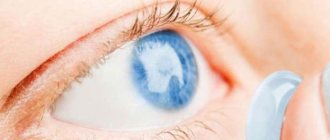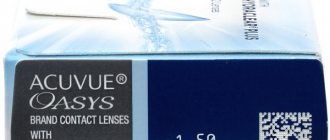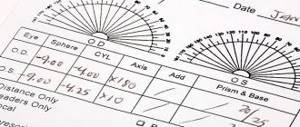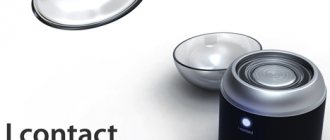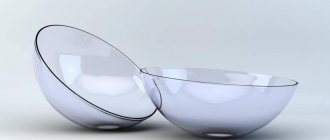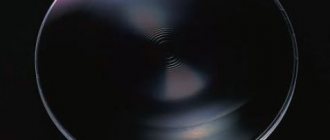Many people are confident that they can purchase lenses without first visiting an ophthalmologist - to do this, it is enough to know their optical power. However, when compiling a prescription, other parameters that affect the effectiveness of lenses are also taken into account. Let's look at why you shouldn't buy optical products without the help of a specialist.
Nowadays, contact lenses can be easily purchased online, as well as in many optical stores. However, it should be remembered that these products belong to medical devices, and therefore their selection must be made by a qualified specialist.
Often, independent choice of lenses is accompanied by such unpleasant consequences as damage to the cornea, as well as “dry eye” syndrome and even infectious and inflammatory processes. To prevent this, you need to choose the right optics by first contacting a specialist.
Why should you see an ophthalmologist?
Today, the choice of lenses is quite large, and the doctor’s main task is to correctly determine which model is right for you and will help to perform effective vision correction. For this purpose, a special examination is carried out, during which the following are determined: visual impairment, as well as the condition of the cornea and conjunctiva, tear production, visual stress regime, previous wearing experience, lifestyle, etc.
As a result, the specialist will write a prescription with detailed characteristics of the required lenses. You can also ask questions about wearing optical products so that you know how to properly care for them.
It is worth noting that a routine vision test performed when selecting glasses differs significantly from consultation on the selection of contact lenses. In this situation, it is necessary to further evaluate the conditions for landing on the cornea.
How to decipher the recipe?
04/04/2019
Historically, prescriptions for medications, glasses or contact lenses were written in Latin. Nowadays, every doctor, optometrist, consultant or technician anywhere in the world will be able to understand what we are talking about. But the user would also like to figure it out, don’t you agree? So, let's go! Vis (visus) is visual acuity. The Vis value without correction ( b/c ) and with correction ( s/c ) is necessary for the specialist to understand what line the patient sees without glasses and with glasses.
OD (oculus dexter) - this is how the right eye is designated (always written first). OS (oculus sinister) is the left eye. In some cases, it may be indicated - OU (oculus uterque), which means “both eyes”.
Vis OD – visual acuity monocularly with the right eye, Vis OS – with the left eye, respectively, Vis OU – with both eyes together.
Sph (sphere, sphere, diopter) is the optical power of a contact or spectacle lens, expressed in diopters. The power of the sphere itself is also sometimes written in Latin. Thus, the “minus” sign will be designated by the word Concave , and the “plus” sign by Convex . A “zero” lens (without diopters) is denoted by the word P lan (planum).
Cyl (cylinder) – cylinder. This parameter shows the astigmatic component of the product if you have been given a prescription for toric lenses (to correct astigmatism), if not, then this item is not filled in. Ax (axis) – axis. More precisely, the position, the inclination of the cylinder axis in degrees – from 0 to 180. The parameter is also set when prescribing astigmatic lenses.
The “ Add and “ Degression ” parameters are indicated in products with complex designs (multifocal, progressive lenses, etc.), when the lenses must be manufactured for several focal lengths. Thus, the addition value will show how much the diopter will be increased towards the plus side at the bottom of the lens, and the degression will show how much the diopter will change towards the minus side at the top of the lens.
Interpupillary distance can be designated as RC, RCT, RMC , D P , D. P. or Dpp (distantia pupillaris) is the distance between the centers of the right and left pupil. The value is necessary for the technician to correctly align the optical axes of the lenses in the glasses.
Prism (prism) – the power of a prismatic lens (such lenses are used to correct strabismus). This value is measured in prismatic diopters and is indicated by pd or a triangle symbol when the recipe is handwritten. And also, when prescribing, they indicate in which direction the base of the prism faces: up, down, outward (toward the temple), inward (toward the nose).
In prescriptions for contact lenses you can find designations in English. For example, R instead of OD (right eye), L instead of OS (left eye), or PWR instead of Sph. The diameter of the lens ( D, D IA - the distance between the edges of the lens, measured through the center) and the base curvature ( BC , R , radius of curvature - the curvature of the inner surface of the contact lens, affecting how the lens “sits” on the eye) can also be indicated. , if the prescribed lens has several different options for diameter and curvature. If this data is not indicated, and only the name of the contact lenses is indicated, do not be alarmed - most likely, this lens is found in a single version, and there is no need to indicate these parameters.
What additional parameters should be considered when choosing lenses?
- Manufacturing method and elasticity of the material. The final shape of lenses having the same radius and curvature can differ significantly due to the use of different polymer materials. This fact must be taken into account when purchasing.
- Individual intolerance to the material. Before replacing one brand of lenses with another or purchasing a color model, a mandatory consultation with a specialist is necessary, as this can cause ocular allergic reactions.
If no more than 1 year has passed since your visit to a contact correction specialist, then to re-purchase lenses you will need to know their name and prescription parameters.
In the MagazinLinz.ru online store you can purchase high-quality optical products from popular manufacturers at a competitive price. Our specialists will promptly answer your questions!
MagazinLinz.ru team
How to read a contact lens prescription?
Table of contents
How to read a contact lens prescription?
Can a glasses prescription be used for contact lenses? Consultation with an ophthalmologist when selecting lenses Prescription form Decoding the parameters of contact lenses Decoding the parameters of toric lenses Decoding the parameters of bifocal and multifocal lenses Example of a prescription for contact lenses AquaOptic solution for lens care How to read a prescription for contact lenses?
You should buy your first contact lenses (CL) only with a doctor's prescription. This is the main rule that will ensure high-quality vision correction and safety of optical products for the eyes.
What information does a recipe contain, and which is most important?
Can a glasses prescription be used for contact lenses?
It is forbidden. Despite the fact that the principle of correcting vision defects in spectacle and contact optics is similar, it must be taken into account that spectacle lenses are located at some distance from the eyes, and contact lenses are worn directly on the cornea. Because of this, the optical power of glasses is usually greater.
What is the difference between a prescription for contact lenses and a prescription for glasses?
The prescription for glasses does not contain information that is crucial when selecting contact optics. In addition to the optical power (for each eye separately), the prescription for CL must indicate:
- base curvature of the back surface;
- specific manufacturer and brand of optical products.
Accurate data can only be obtained after trying on the selected model and assessing the reaction of the eyes. By default, the prescription is valid for 1 year. If during this time you have not purchased a contact lens, then before purchasing you need to be examined by an ophthalmologist again. It is highly advisable to have your previous prescription with you so that the specialist can assess the rate and extent of refractive changes.
Consultation with an ophthalmologist when selecting lenses
Try to find a doctor who specializes in fitting contact optics. All measurements are made using special devices that automatically generate examination results.
If you have not worn contact optics before, then in addition to identifying existing refractive errors - myopia, farsightedness, astigmatism - the doctor must make sure that there are no contraindications:
- inflammatory eye diseases;
- blepharitis;
- keratitis;
- strabismus.
Recipe form
The document must indicate all of the above parameters. The prescription can be written on a standard form or on the letterhead of a clinic or doctor. As a rule, the main parameters are indicated in Latin letters, so try to remember their meaning.
If there is no sign when indicating the optical power, then the default value is considered “plus”. All basic lens parameters must match the data on the packaging of optical products. In the prescription they are indicated for each eye separately. If the values differ, two packs of lenses are purchased.
Deciphering the parameters of contact lenses
In the recipe you will find the following symbols:
- eye – OS (left), OD (right);
- optical power - SPH, measured in diopters (D). The “+” sign means farsightedness, the “–” sign means myopia;
- radius of curvature – BC, calculated in millimeters and corresponds to the curvature of the cornea;
- Diameter – DIA, indicates the actual size of the lens. This option is indicated only if the patient requires lenses of a non-standard size.
Decoding the parameters of toric lenses
To correct astigmatism (curvature of the corneal surface), which reduces the clarity of vision, toric lenses are prescribed. They have a spherocylindrical shape, therefore, for correct selection, the recipe additionally indicates the optical power of the cylinder (CYL) and the angle of inclination of the axis (AXS) in degrees.
Decoding the parameters of bifocal and multifocal lenses
With an age-related decrease in accommodation - the ability to see objects clearly and clearly both near and far - a diagnosis of “presbyopia” is made. To correct such a vision defect, bifocal and multifocal lenses are used, which have two or more optical zones with different diopter values.
Addition – ADD, a parameter that shows the difference in diopters between optical zones.
Example of a contact lens prescription
In addition to the parameters of contact lenses, the prescription may contain additional information, for example, the purpose (for work, for constant wear, etc.), doctor’s recommendations, which indicate the wearing mode and frequency of replacing optical products, and the name of care products.
For example, a prescription for a patient with farsightedness and astigmatism might look like this:
Manufacturer and brand name: ACUVUE OASYS HYDRACLEAR-PLUS FOR ASTIGMATISM
| SPH | B.C. | CYL | AXS | ADD | |
| O.D. | + 2,5 | 8,6 | — 0,75 | 82 | 1,5 |
| OS | +3,0 | 8,6 | — 0,5 | 76 | 1,5 |
AquaOptic solution for lens care
You can use the multifunctional solution “AquaOptic” as a daily care product. Due to natural components - hyaluronic and succinic acid - it maintains stable hydration of lenses throughout the day, carefully cleanses of dust and fatty deposits and at the same time disinfects.
Moisturizing, cleansing and protecting with one product is convenient not only for beginners, but also for those who have worn contact lenses for several years.
What are prescription glasses lenses?
07/22/2019
The concept of a prescription lens is quite broad and does not imply any specific type of lens for glasses. In simple terms, these are the lenses that are manufactured at the factory individually for a specific client.
Indications for such an order may be specific vision parameters (high degree of myopia or hypermetropia, tall cylinders, non-standard interpupillary distance, etc.), applying a premium coating to the lens, or manufacturing lenses with a complex optical design (for example, bifocal, office or progressive lenses). The reason may even be the desire to laser engrave the client’s name on the lens (yes, this option is also possible).
Thus, everything that does not fall under the concept of “Stock” - “Warehouse” (what is produced and is available to manufacturers as a regular stock, a ready-made template) receives the proud name “RX” - “Formulation” (non-standard lens made personally on prescription). Let's give a couple of examples. Let's say you are a tall and stately man with size 47 feet. Finding shoes for this size in regular stores is quite difficult, so they usually have to be made to order. And to make them as convenient as possible, the seller will take several measurements and pass these parameters on to the master. Or maybe you are a beautiful girl who fits all the standards of an ideal figure? In this case, any store will be able to offer you a dress in size, but you want maximum comfort and individuality, and you order an exclusive dress from a tailor. Only you will have this and it will “sit” perfectly. As for spectacle lenses, here we have a huge scope for individualization:
— With the help of highly qualified specialists and special programs from manufacturers, we can order a lens in which edge errors (and image distortion as a consequence) will be minimized - the “prism” or “rainbow” effect, which is sometimes noted by users of glasses with large glasses, is leveled out. diopters.
— Custom lenses are indicated for those who, for example, have a distance from the left pupil to the bridge of the nose that is not equal to the distance from the right pupil to the bridge of the nose. Today, it is possible to manufacture individual spectacle lenses, even taking into account the position of wearing glasses and the fitting parameters of the frame.
- For astigmatism, a custom lens is often a necessity because most stock eyeglass lenses are available with a +/- 2 diopter cylinder, while prescription lenses can be made with up to 6 and even 9 diopter cylinders.
— In the case of anisometropia (a significant difference in the refraction of the left and right eyes from each other), it is difficult to achieve good results using spectacle correction, however, if you order an individual prescription using such a prescription, the chances will increase. This is possible because the order comes with both the right and left lenses indicated, and therefore is considered by the manufacturer as a single optical system. In addition to technologies for equalizing lenses of unequal thickness, techniques are also used to equalize image sizes visible through such glasses.
— We can also make glasses in which you will see perfectly at all distances, without experiencing discomfort when your gaze shifts to the side.
— Thanks to the formulation, you can get photochromic (darkening), tinted in a certain color, and even a mirrored corrective lens in those shades that best suit your clothing style or mood.
— Prescription lenses are available for order in larger and smaller diameters than stock ones. And this means that the field for choosing a medical frame suitable for your spectacle lenses (with a suitable eyepiece size) is also expanding. It should be noted that ordering glasses with prescription lenses, by sending the order to the manufacturer's factory and creating the lenses from scratch, requires longer production times than ordering with regular stock lenses. However, these terms are not critical and it is really worth it.
It doesn’t matter what the reason for ordering lenses through the RX line is - medical indications or the desire to stand out, you can take advantage of this opportunity at any time. And the Lenza for Free specialists will be happy to help you with this.
